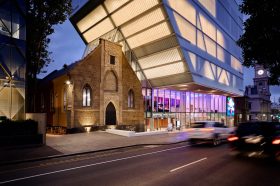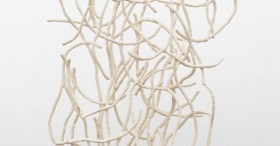The 2016 Fisher’s Ghost Art Award exhibition. Photo Credit: Document Photography.
Abandoned towns, dusty portraits, and disturbingly lifelike sculptures are among the conventional trappings of ghost stories – vibrant community festivals and innovative contemporary art, less so. But the Fisher’s Ghost Art Award has a vitality and dynamism unfettered by the spectre of Frederick Fisher, whose legend is celebrated over the ten-day Campbelltown Annual Festival of Fisher’s Ghost. A highlight of the festival, the award exhibits the edge of contemporary art, with past winners including some of Australia’s most exciting contemporary artists, such as Elisabeth Cummings, Khaled Sabsabi, and Raquel Ormella.
The legend of Fisher’s ghost derives from the murder of Campbelltown farmer Frederick Fisher in the early 19th Century. The story goes that after four months after Fisher disappeared a neighbour farmer saw Fisher’s ghost point towards the property of William George Worrall’s. The ghost story prompted authorities to investigate the property, where they found Fisher’s corpse Worrall was subsequently hanged for the murder.
The story of Fisher’s ghost has inspired filmmakers, authors, playwrights and poets. Through the Fisher’s Ghost Art Award, the legend continues to influence the creation of new artwork.
Michael Dagostino, Director Campbelltown Arts Centre, says that the award showcases ‘high quality works from artists who are pushing the boundaries’. Campbelltown Arts Centre is proud of the diversity of entries that the prize has received across a broad spectrum of different media and artistic disciplines. ‘We received close to a thousand entries last year, and exhibited over five hundred”.
Lately the prize has received a boom in digital artwork, including video.
The variety of artwork submitted to the Fisher’s Ghost Art Award is evident from the variety of categories in the competition:
- Open
- Traditional
- Contemporary
- Drawing, Painting and Printmaking
- Sculpture
- Photography
- James Gleeson Surrealism Award
- Aboriginal Art Award
The winner of last year’s Open award was Darren Sylvester, whose work Green Editorial, was described as ‘compelling’ and a ‘stand out’, with particular praise given to the way the gaze of the subjects appeared to follow the viewer.

Green Editorial, by artist Darren Sylvester
In addition to these categories, two categories are open specifically to entrants from the Macarthur region: an open Macarthur category for all artists from the region and the Macability category specifically for artists with a disability. There are also three awards given to entries by primary school students, and three given to entries by secondary school students. In 2016, the competition received over two hundred entries from school students, which Dagostino described as a ‘great showing of young talent’.
The winner of last year’s Macability category was Amy-Claire Mills, whose video work Mycobacterium Abscessus depicts a woman with bright pink dye, reminiscent of bodily fluids, around her mouth and torso, retching visibly struggling to breathe against a variety of backgrounds. The confronting, powerful artwork drew the attention of judges and visitors to the exhibition. Macarthur artist Carmen Sandy won the Macarthur category with her piece Thinawan Mayan (Emu Waterholes), which was in the form of a woven mat surrounded by feathers.

Thinawan Mayan (Emu Waterholes), by artist Carmen Sandy
The competition is judged by a panel of three judges that changes every year, with judges selected from among esteemed peers within the arts community. The panel often includes winners of the competition from previous years.
Now entering its 55th year, the Fisher’s Ghost Art Award continues to draw entrants from across the globe, with a prize pool totalling over $30,000. A maximum of two artworks per artist can be entered, with no more than one artwork per category, and there is an entry fee of $25 per artwork ($5 per work for school students). The exhibition is held from the first week in November, with the winning entry in the Open category receiving a prize of $20,000 and acquired by the Campbelltown Arts Centre, where it becomes part of the permanent collection.
For more information visit http://c-a-c.com.au/





